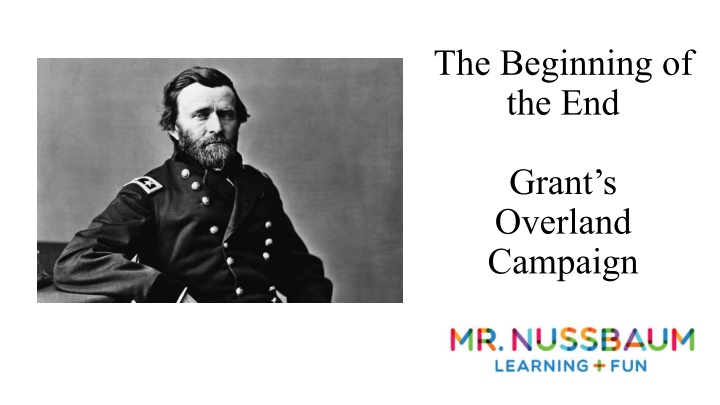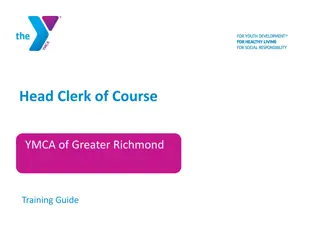The Overland Campaign: Grant's Push Towards Richmond
Confederate defeat at Gettysburg and Vicksburg sets the stage for Grant's strategic moves towards Richmond in 1864. Battles at the Wilderness, Spotsylvania, and Cold Harbor mark key turning points in the Civil War as Grant seeks to defeat Lee's forces and bring the war to a decisive end.
Download Presentation

Please find below an Image/Link to download the presentation.
The content on the website is provided AS IS for your information and personal use only. It may not be sold, licensed, or shared on other websites without obtaining consent from the author.If you encounter any issues during the download, it is possible that the publisher has removed the file from their server.
You are allowed to download the files provided on this website for personal or commercial use, subject to the condition that they are used lawfully. All files are the property of their respective owners.
The content on the website is provided AS IS for your information and personal use only. It may not be sold, licensed, or shared on other websites without obtaining consent from the author.
E N D
Presentation Transcript
The Beginning of the End Grant s Overland Campaign
Where are we in the Civil War? Confederate forces had been defeated at the epic Battle of Gettysburg in Pennsylvania in July 1863. Their attempt to invade the North was unsuccessful and their quest for foreign recognition was ruined. On July 4th, Confederate forces finally surrendered at Vicksburg, giving the Union control of the Mississippi River, and isolating Texas, Arkansas, and Louisiana. The only hope for the Confederacy was the drag the war on indefinitely so that the Union would lose to will to fight. We start in early 1864 We start in early 1864
1864 President Lincoln replaces General Meade as Commander of the Army of the Potomac with Ulysses S. Grant, who had previously engineered major (but costly) Union victories at Shiloh and Vicksburg. Grant, although a fighter, had a reputation for messiness in appearance, and for drinking too much. Ulysses S. Grant
The Plan Like many of his predecessors, Grant endeavored to defeat the Confederacy by moving on its capital, Richmond. Grant believed this end could be accomplished if he could place his massive army in between Lee s Army of Northern Virginia and Richmond. The other goal was to use his manpower advantage to systematically reduce Lee s forces. A series of three violent battles and many skirmishes would ensue in 1864, in what came to be known as Grant s Overland Campaign
The Wilderness On May 5, 1864, Grant led his army to a thick tangle of jungle-like forests near Fredericksburg known simply as the Wilderness. Grant wanted to avoid fighting here, but Lee forced his hand by moving his army to intercept him. Violent fighting ensued as the forests caught fire. Over 29,000 casualties were recorded here over two days, nearly 18,000 of which were of the Union. Despite the casualties, Grant would not be deterred and continued to the south and east to try to place him army between Lee s and Richmond.
Spotsylvania Lee s Army next me Grant at Spotsylvania as Grant continued the push to put his army in between Lee s and Richmond. This violent battle lasted two weeks resulting in over 32,000 casualties and much hand-to-hand combat. Much like the Wilderness, the battle is considered a draw, although the violence has reduced Lee s Army more than it has Grant s. Grant continues to push to the southeast.
Cold Harbor Now only ten miles from Richmond, Union forces and Confederate forces again clash on May 31, 1864, at Cold Harbor. Lee s Army and his reinforcements were successful in building fortifications that extended seven miles. These proved impossible for the Union Army to breach, and Confederate forces routed them. Grant suffered 13,000 Casualties compared to Lee s 6,000. Grant would later admit that fighting at Cold Harbor was his worst decision of the war, and he feared it served to improve Confederate morale.
Effects of the Overland Campaign Lee s impressive victory at Cold Harbor would be his last in the Civil War. Despite Lee s victory, Union forces would move across the James River, in preparation for launching a major attack on Petersburg a crucial railroad junction 40 miles south of Richmond, that served as its most important supply line. Lee was forced to collapse his defenses to Petersburg and Richmond for what could be a final stand.
Grants Position Summer 1864 Although Grant s initial hope was to destroy the Army of Northern Virginia, he changed his objective. Now, he would use strategy and patience to create a hopeless situation for the Confederates. He planned to besiege the city of Petersburg, something, at this point, Lee was powerless to prevent. A prolonged siege was not ideal, but it meant the beginning of the end for Lee s Army. How long could they hold out?























